Karyolysis - Study guides, Class notes & Summaries
Looking for the best study guides, study notes and summaries about Karyolysis? On this page you'll find 85 study documents about Karyolysis.
Page 4 out of 85 results
Sort by
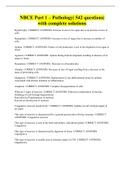
-
NBCE Part 1 – Pathology| 542 questions| with complete solutions
- Exam (elaborations) • 37 pages • 2023
- Available in package deal
-
- $12.99
- + learn more
Hypertrophy CORRECT ANSWERS: Increase in size of an organ due to an increase in size of cells Hyperplasia CORRECT ANSWERS: Increase in size of organ due ot increase in number of cells. Aplasia CORRECT ANSWERS: Failure of cell production. Lack of development of an organ or tissue Agenesis CORRECT ANSWERS: Aplasia during fetal development resulting in absence of an organ or tissue Hypoplasia CORRECT ANSWERS: Decrease in cell production. Atrophy CORRECT ANSWERS: Decrease in siz...

-
Wolfpacc Endo Clues Questions with Correct Answers And Complete Solutions.
- Exam (elaborations) • 21 pages • 2024
-
- $13.99
- + learn more
Wolfpacc Endo Clues Questions with Correct Answers And Complete Solutions. What is pyknosis - -Nucleus turns into blobs d/t shrinkage What Ab(s) is/are a/w Type 1 DM - -Anti-islet cell, anti-GAD What is Grave's Disease - -Hyperthyroid: exophthalmos, pretibial myxedema, weight loss, tachycardia, dry skin What Ab(s) is/are a/w Grave's Disease - -Anti-TSHr What is Hashimoto's - -Hypothyroid: weight gain, bradycardia What Ab(s) is/are a/w Hashimoto's - -Anti-microsomal; anti-TPO What are ...
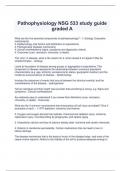
-
Pathophysiology NSG 533 study guide graded A
- Exam (elaborations) • 15 pages • 2024
- Available in package deal
-
- $11.49
- + learn more
What are the five essential components of pathophysiology? - 1. Etiology (Causative mechanisms) 2. Epidemiology (risk factors and distribution in populations) 3. Pathogenesis (disease mechanism) 4. clinical manifestations (signs, symptoms and diagnostic criteria) 5. Outcomes (cure, remission, chronicity, or death) The "why" of disease- what is the reason for it- what caused it to happen? May be simple/complex. - etiology Looks at the pattern of disease among groups or aggregates or ...
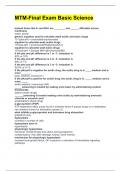
-
MTM-Final Exam Basic Science
- Exam (elaborations) • 20 pages • 2024
-
- $14.98
- + learn more
MTM-Final Exam Basic Science Ionized forms like A- and BH+ are ________ and ______ diffusible across membrane water; poorly generic equation used to calculate week acidic and basic drugs 10 ^(pka-pH) = protonated/unprotonated equation to calculate weak acidic drugs 10^(pka-pH) = [nonionized(HA)]/[ionized(A-)] equation to calculate weak basic drugs 10^(pka-pH) = [ionized (BH+)]/[nonionized(B0] if the pka and pH difference is 1 or -1: ionization is 90% or 10% if the pka and pH differe...

-
MTM-Final Exam Basic Science
- Exam (elaborations) • 20 pages • 2024
-
- $9.49
- + learn more
MTM-Final Exam Basic Science Ionized forms like A- and BH+ are ________ and ______ diffusible across membrane water; poorly generic equation used to calculate week acidic and basic drugs 10 ^(pka-pH) = protonated/unprotonated equation to calculate weak acidic drugs 10^(pka-pH) = [nonionized(HA)]/[ionized(A-)] equation to calculate weak basic drugs 10^(pka-pH) = [ionized (BH+)]/[nonionized(B0] if the pka and pH difference is 1 or -1: ionization is 90% or 10% if the pka and pH differe...
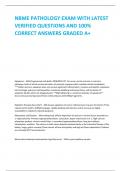
-
NBME PATHOLOGY EXAM WITH LATEST VERIFIED QUESTIONS AND 100% CORRECT ANSWERS GRADED A+
- Exam (elaborations) • 20 pages • 2024 Popular
-
- $20.99
- 1x sold
- + learn more
NBME PATHOLOGY EXAM WITH LATEST VERIFIED QUESTIONS AND 100% CORRECT ANSWERS GRADED A+ Apoptosis: - ANS-Programmed cell death. REQUIRES ATP. Can occur via the intrinsic or extrinsic pathways, both of which involve activation of cytosolic caspases which mediate cellular breakdown. ***Unlike necrosis, apoptosis does not involve significant inflammation. Involves eosinophilic cytoplasm, cell shrinkage, pyknosis and basophilia, membrane blebbing and karyorrhexis, and formation of apoptot...
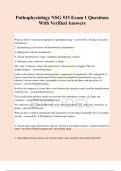
-
Pathophysiology NSG 533 Exam 1 Questions With Verified Answers
- Exam (elaborations) • 18 pages • 2024
-
- $12.49
- + learn more
Pathophysiology NSG 533 Exam 1 Questions With Verified Answers What are the five essential components of pathophysiology? - answer1. Etiology (Causative mechanisms) 2. Epidemiology (risk factors and distribution in populations) 3. Pathogenesis (disease mechanism) 4. clinical manifestations (signs, symptoms and diagnostic criteria) 5. Outcomes (cure, remission, chronicity, or death) The "why" of disease- what is the reason for it- what caused it to happen? May be simple/complex. - answ...

-
PATH 3610 Midterm Testbank - All Midterm Exam Questions and Answers
- Exam (elaborations) • 32 pages • 2023
-
- $13.99
- + learn more
ATH 3610 Midterm Testbanks Midterm 1 Question 1: The release of cytoplasmic enzymes from necrotic cells may be useful diagnostically. a. True b. False Question 2: Bilirubin is: a. Lipid soluble when conjugated b. Water soluble when conjugated c. Conjugated in the kidney for excretion in the urine Question 3: Agents such as radiation, mutagenic drugs and viruses can lead to acquired DNA abnormalities. Damage to cells such as blood cell precursors in the bone marrow is the result of: a....

-
Patho NSG 533- module 1 - Cell Injury/Death/Adaptation
- Exam (elaborations) • 12 pages • 2023
- Available in package deal
-
- $11.99
- + learn more
Patho NSG 533- module 1 - Cell Injury/Death/Adaptation The five components of the disease process are etiology.... The five components of the disease process are: 1. etiology (causative mechanisms) 1. epidemiology (risk factors and distribution in populations) 3. pathogenesis (disease mechanisms) 4. clinical manifestations (signs, symptoms, and diagnostic criteria) 5. outcomes (cure, remission, chronicity, or death). What is etiology? Etiology is the "why" of disease--what is the...

-
NURS 209 Practice Questions HESI (PATHO BOOK). Latest Bank Questions with rationale answers
- Exam (elaborations) • 88 pages • 2023
- Available in package deal
-
- $11.49
- + learn more
NURS 209 Practice Questions HESI (PATHO BOOK). Latest Bank Questions with rationale answers Document Content and Description Below A decrease in workload, use, pressure, or blood supply appropriately describes: A. physiologic atrophy. B. pathologic atrophy. C. hypertrophy. D. hyperplasia. - B. pathologic atrophy. Pathologi c atrophy is a decrease in cell size due to decreased use. Physiologic atrophy usually occurs early in development; for example, the thymus gland atrophies during childhood....

Study stress? For sellers on Stuvia, these are actually golden times. KA-CHING! Earn from your study resources too and start uploading now. Discover all about earning on Stuvia


